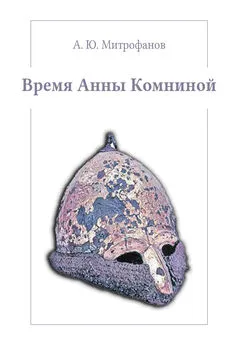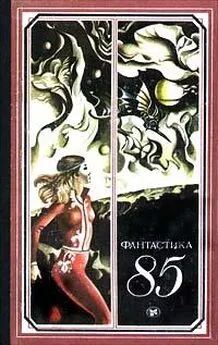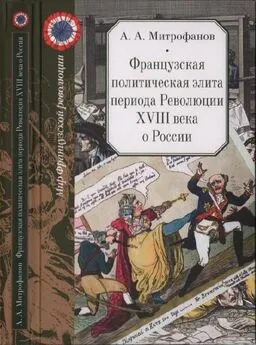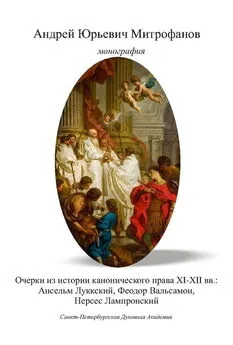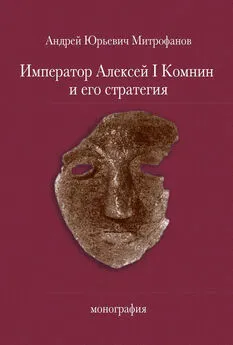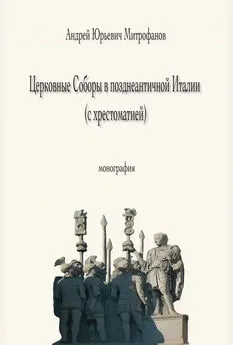Андрей Митрофанов - Время Анны Комниной
- Название:Время Анны Комниной
- Автор:
- Жанр:
- Издательство:неизвестно
- Год:2021
- Город:СПб
- ISBN:978-5-906627-85-8
- Рейтинг:
- Избранное:Добавить в избранное
-
Отзывы:
-
Ваша оценка:
Андрей Митрофанов - Время Анны Комниной краткое содержание
В монографии ставится вопрос о возможном монгольском происхождении династии Великих Сельджукидов. Также подробно исследуются фрагменты «Алексиады», посвященные феномену византийского самозванчества, воспринятого русской политической культурой и проявившегося в период Смутного времени.
В книге исследуется состояние описанных Анной армии Византийской империи и норманских отрядов. Делается вывод о латинизации византийской военной аристократии в эпоху императора Алексея I Комнина.
Рекомендуется преподавателям и студентам богословских и светских вузов, а также всем интересующимся историей Византии.
В формате PDF A4 сохранен издательский макет книги.
Время Анны Комниной - читать онлайн бесплатно ознакомительный отрывок
Интервал:
Закладка:
Автор подробно исследует состояние описанных принцессой Анной вооруженных сил Византийской империи и норманнов, и приходит к выводу о вестернизации византийской военной аристократии в эпоху императора Алексея Комнина. При этом мнения ряда исследователей, утверждающих, что принцесса Анна не была автором оригинального сочинения, а лишь литературно обработала записки своего мужа Никифора Вриенния, хорошо разбиравшегося в военном деле, подвергнуты критике. Анна Комнина, по мнению А. Ю. Митрофанова, вела самостоятельную исследовательскую работу и имела доступ не только к запискам Никифора Вриенния или показаниям епископа Бари – о чем писал Я. Н. Любарский, – но также к несохранившимся воспоминаниям Георгия Палеолога и Татикия.
Книга А. Ю. Митрофанова «Время Анны Комниной» – отнюдь не сухая научная монография, но исследование, написанное живым литературным языком, и этим она выгодно отличается от многих современных публикаций по истории Византии. Можно даже утверждать, что автор книги стремится подражать своей главной героине – принцессе Анне Комниной.
Один мудрец как-то сказал, что Бог определяет долготу человеческой жизни, а широту жизни определяет сам человек. Судьба Анны Комниной в полной мере подтверждает эти слова, ибо августейшая принцесса сумела вместить в своей творческой жизни целую эпоху византийской истории…
Summary
The book “The Time of Anna Komnena” by A. Yu. Mitrofanov is devoted to the reflection of the reign of Emperor Alexios I (1081–1118) and his era in the main work of his daughter, Princess Anna Komnena (1083–1153/1154), which is known as the “Alexiad”. As noted by the prominent Byzantintinist and Art Historian Hans Belting, Emperor Alexios I was depicted by Anna Komnena as a “living icon” (als lebende Ikone) [6] Belting H. Bild und Kult, München, 1990, S. 572.
. However, A. Yu. Mitrofanov proves that despite the desire of Anna Komnena to write a laudatory biography of her father, in reality, the “Alexiad” far exceeded the genre framework of the panegyric and became a mirror of the era, the fate of which largely determined the reign of Emperor Alexios I. Anna Komnena wrote the “Alexiad” thirty years after the death of her father and the unsuccessful attempt at a palace coup, which led Anna Komnena to an honorable exile in the monastery of the Most Holy Theotokos of Grace “Kecharitomene”. There the princess wrote the Alexiad during the turbulent reign of her nephew, Emperor Manuel I Komnenos (1143–1180), who, at the cost of incredible efforts, tried to retransform the Byzantine Empire into a military and political hegemon, as the Byzantine Empire was in the era of Emperor Justinian I the Great (527–565) and Emperor Basil II the Bulgar Slayer (976–1025). According to A. Yu. Mitrofanov, the “Alexiad”, written by Anna Komnena around 1146–1148, was a kind of political testament to her nephew of the imperial family and at the same time an opposition manifesto, which had been directed against his pro-Latin policy. According to A. Yu. Mitrofanov, it was the combination of a biography, of a historical chronicle and of a current political manifesto, which made Anna Komnena’s “Alexiad” the book that Karl Krumbacher rightly called “the best historical work that the Middle Ages left us» [7] Krumbacher K. Geschichte der Byzantinischen Literatur von Justinian bis zum Ende des Oströmischen Reiches (527–1453). München, 1891. S. 78–81.
. As A. Yu. Mitrofanov notes, some of the court intrigues described by Anna Komnena, in particular, the romantic relationship of the Empress Maria of Alania and Alexios Komnenos, find parallels in the work of the Seljuk poet Fakhruddin Gurgani (XI thcentury), who wrote in Persian and, according to V. F. Minorsky, relied on the lost Parthian knight’s novel [8] Minorsky V. Vis u Ramin: A Parthian Romance // Bulletin of the School of Oriental and African Studies. 1943–1946. Vol. XI. P. 741–763; 1947–1948. Vol. XII. P. 20–35; 1954. Vol. XVI. P. 91–92; “New Developments”. 1962. Vol. XXV. P. 275–286.
.
As A. Yu. Mitrofanov shows, Anna Komnena, being a memoirist, not only created a gallery of portraits of prominent representatives of the Byzantine imperial dynasties, such as her father – Emperor Alexios Komnenos, her mother – Empress Irina Dukena, her grandmother – Anna Dalassena, the mother of her fiancé, her mother in-Law – Empress Maria of Alania, but, she, being a historian, outlined a number of ethnographic and political problems, which were faced by the Byzantine Empire at the end of the XI thcentury. One of these problems was the arise of the power of the Great Seljuks, who conquered under the standard (Bunchuk) of the sultans Togrul-bey (1038–1063), Alp-Arslan (1063–1072) and Malik Shah (1072–1092) Khorasan, Iran and vast areas from the Mediterranean Sea to Kashgaria, from the Caucasus to Yemen. Although the result of the Seljuk conquests was the appearance of the Seljuks in Byzantine Asia Minor and the rapid conquest of the peninsula, however, the feuds between the great Sultan Malik Shah and the Anatolian Seljuks pushed the Emperor Alexios Komnenos into an alliance with Malik Shah against the Sultanate of Rumia. Moreover, Alexios Komnenos had already used the help of the Seljuks during the war against Roussel de Bailleul – a rebellious Norman knight who tried to create his own principality on the territories of the ancient Byzantine “Armeniac” Theme in 1074.
A. Yu. Mitrofanov raises the question of the possible Mongolian origin of the Great Seljuk dynasty in the light of the military and political influence of the Khitan Liao Empire in Turkestan in a new way and gives interesting arguments in favor of this assumption. One of these arguments is the author’s thesis about the deliberate ignoring of the role of the Mongolian factor in the history of Central Asia, an ignoring which is characteristic of Soviet Oriental studies. This thesis of the author particularly is based on the opinion of the excellent archaeologist, ethnographer and artist M. V. Gorelik. Another argument of A. Yu. Mitrofanov is the original assumption that there is a literary influence of the Abulqasem Ferdowsi’s “Shahnameh” on the history of Seljuk from the “Malik-nameh” – a Seljuk epic of the XI th–XII thcenturies, which has been preserved in fragments thanks to the work of Mirkhond and some other late Eastern historians. For this remarkable discovery A. Yu. Mitrofanov also refers to the works of G. V. Vernadsky, who noted the spread of the Christianity among some Mongolian tribes in the XI th–XII thcenturies. The author A. Yu. Mitrofanov compares this phenomenon of the Christianity among some Mongolian tribes with the hypothesis of the Christian confession of some of the Seljuk’s sons, in particular, Mikail.
Furthermore A. Yu. Mitrofanov also examines in detail the fragments of the work of Anna Komnena, which were dedicated to the phenomenon of so called Byzantine imposture . According to A. Yu. Mitrofanov, one of the first examples of Byzantine imposture arrived at the end of the reign of Emperor Leo III the Isaurian (717–741) with the appearance of the impostor Pseudo-Tiberius Pergamenus, who declared himself the surviving son of Emperor Justinian II Rhinotmetos (685–695, 705–711). The name of Justinian’s II son was Tiberius and he has been murdered as a child of eleven years old in 711 in front of his grandmother – Empress Anastasia. Drawing on the research of Paul Speck and others [9] Speck P. Kaiser Leon III., Die Geschichtswerke des Nikephoros und des Theophanes und der Liber Pontificalis, T. I., Die Anfänge der Regierung Kaiser Leons III, Ποικίλα Βυζαντίνα 19, Bonn, 2002, S. 115–187.
, A. Yu. Mitrofanov suggests that the hypothetical story of the “Life of Leo” (*Vita Leonis) about the murder of Tiberius, which had been reproduced in the “Chronography” of Theophanes the Confessor, probably has been interpolated during the rebellion of Pseudo-Tiberius Pergamenus to uncover him.
According to sources of the “dossier” of George Synkellos, one of them is, for example, a hypothetical “History of Leo and Constantine” (*HL), which had been followed by Theophanes the Confessor in the narrative of Byzantine history after the year 718, Pseudo-Tiberius Pergamenus received the support of the Umayyad Caliph Hisham Ibn Abdal-Malik (723–743) [10] Speck P. Kaiser Leon III., Die Geschichtswerke des Nikephoros und des Theophanes und der Liber Pontificalis, T. II., Eine neue Erkenntnis Kaiser Leons III, T. III., Die Aπόστασις ῾Ρώμης και Ἰταλίας und der Liber Pontificalis , Ποικίλα Βυζαντίνα 20, Bonn 2003, S. 513–514.
. Such reliance on external enemies of the Byzantine Empire was characteristic of later Byzantine impostors , to whom Anna Komnena was contemporary. That is why Mitrofanov examines in detail the fragments of Anna Komnena on the impostors Pseudo-Michael and Pseudo-Diogenes I Furthermore the Author mentions out of the Russian Chronicles the rebellion of the impostor Pseudo-Diogenes II “Devgenevich” and the rebellion of his son, the Pseudo-Prince Vasilko Leonovich.
Pseudo-Michael was a protégé of the Normans and Robert Guiscard personally; Pseudo-Diogenes I relied on the help of the Cuman Khan Tugorkan, while Devgenevich and Pseudo-Prince Vasilko enjoyed the support and official recognition of the Grand Duke of Kiev Vladimir Monomakh (1113–1125).
Vladimir Monomakh even related himself to the impostor Devgenevich by marring his daughter Maritsa to him. Their son was the impostor Pseudo-Prince Vasilko. On the basis of these undeniable historical facts, proved by A. Yu. Mitrofanov, the phenomenon of Byzantine imposture , which had been largely documented and described by Anna Komnena and other Byzantine historians, mentioned by the Author, proves to be an old and well known strategy of impostors on the byzantine imperial throne. This phenomenon is repeated by Russian political culture. This circumstance manifested itself many centuries later during the Time of Troubles (1605-1613) and during the reign of Empress Catherine the Great (1762–1796), and then influenced the formation of the phenomenon of Soviet leaders and Soviet totalitarianism.
A. Yu. Mitrofanov explores in detail the state of the armed forces of the Byzantine Empire and the Normans who were extensively documented by Anna Komnena, and he comes to the conclusion about the Westernization of the Byzantine military aristocracy in the era of the Emperor Alexios Komnenos. A. Y. Mitrofanov criticizes the views of some researchers who claim that Anna Komnena was not an author of an original work, but only treated the notes of her husband, Nikephoros Bryennios, who was well versed in military Affairs.
Читать дальшеИнтервал:
Закладка:
